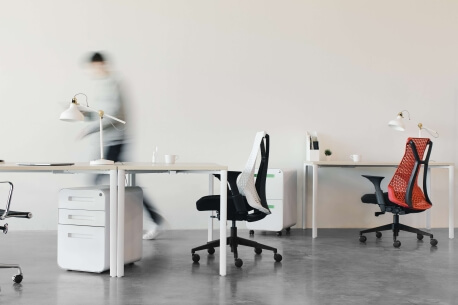
24 Mar Is your flooring safe for the return to work?
With the return to the workplace fast approaching, now is the time to assess the flooring within yours. To ensure your environment remains risk free and safe for all employees, you will need to consider the condition of your floors. As an aspect that many business owners overlook when it comes to evaluating safety levels, we are here to provide you with some pointers on guaranteeing that your flooring remains risk free for your employees.
Visible factors to assess
Take the time to assess your workplace flooring visually. You may need to move the furniture around to get an accurate representation of its condition, especially where heavy machinery or workplace equipment has been left for the last year, where chairs or doors may have worn the flooring away or where heavy footfall may have left an impact.
Look for signs of natural wear and tear, specifically around these locations, such as the fraying, lifting or curling of carpet tiles, or cracks, splits and denting within vinyl, linoleum or ceramic flooring. You will also want to assess the skirting boards and door thresholds, checking that flooring of any type has a sleek and smooth transition into the next room or meets the wall without lifting, removing potential trip hazards.
Physical factors to consider
If your flooring appears to be in healthy condition, you may want to assess the physical factors and make a decision on whether they will have a sudden impact on your flooring, resulting in you calling for a repair or replacement once working life returns to normal and causing further disruption.
Lifespan. You will need to take into consideration the lifespan of your flooring. Think back to when it was installed and how much it has endured since. If it is approaching the end of its predicted life expectancy, it may be worth calling for a professional assessment, saving your employees from disturbance once your workplace reopens.
Footfall. You will want to assess the traffic levels within each area of your workplace, whether that is the route from desk to kitchen, the flooring surrounding workstations and relaxation areas or within restrooms and meeting spaces. These locations with heavier footfall are likely to experience natural wear and tear sooner than those with less, so you should make an accurate decision on the potential safety of your flooring dependant on the current condition of these areas of flooring.
Maintenance. Your flooring may be relatively new and so you may assume that it will remain safe for the return to work, but if not installed correctly, it may have led you to experience a number of issues which required specialist maintenance, from repairs to replacements. Having a year away from the office will not have eliminated these problems, but instead put them on hold, resulting in them reappearing once utilised again later this year.
If you have come to the conclusion that your staff would benefit from a safe flooring replacement, there are a range that you could consider, each with their own benefits for many types of workplaces.
Carpet tiles
Perfect for larger or louder businesses which require a level of sound insulation. They also assist in keeping the workspace warmer.
Vinyl flooring
Ideal for offices with high levels of footfall as the commercial flooring remains extremely durable and resistant to damage.
Rubber flooring
The ultimate flooring choice in workspace locations such as gyms due to their robustness under heavy weight and slip-resistant qualities against moisture.
Linoleum flooring
A cost-effective and easy to clean option for businesses which desire a naturalistic vibe with high durability.
Here at Easifit Flooring, we are on hand to provide workspaces with expert advice and specialist flooring services. Talk to a member of our team for assistance or to arrange for an appointment. Call 0800 096 1171 or email and we will be happy to help prepare your workplace for the safe return of your employees.
March 24, 2021

































